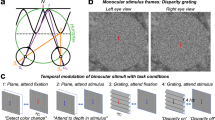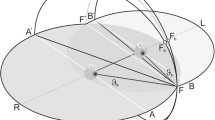Summary
Static photographic evidence of the occurrence of cyclovergence is presented that supports and extends the result of Crone and Everhard-Halm (1975). Wide-angle complex targets were a necessary condition; simple horizontal line targets were insufficient. Our asymmetrical disparity targets supported in part the conformance of cyclovergence to Hering's Law but raised questions relating to the computational process that also acts to remove cyclodisparity and permits cyclofusion. Saturation and hysteresis nonlinearities were observed.
Similar content being viewed by others
References
Ames, A., Jr.: Cyclophoria. Am. J. Optom. Physiol. Optics 7, 3–38 (1926)
Crone, R.A., Human cyclofusional response. Vision Res. 11, 1357–1358 (1971)
Crone, R.A., Everhard-Halm, Y.: Optically induced eye torsion. Albrecht von Graefes Arch. Klin. Ophthalmol. 196, 231–237 (1975)
Diner, D.R.: Hysteresis in human binocular fusion: a second look. Ph.D. thesis, Calif. Institute of Technology, Pasadena, California 1978
Ellerbrock, V.J.: Experimental investigation of cyclofusion. Amer. J. Optom. 23, 327–341 (1946)
Ellerbrock, V.J.: Inducement of cyclofusional movements. Amer. J. Optom. 31, 553–556 (1954)
Fender, D.H., Julesz, B.: Extension of Panum's fusional area in binocularly stabilized vision. J. Optical Soc. Amer. 57, 819–830 (1967)
Hering, E.: Die Lehre vom binocularen Sehen. Leipzig: Englemann 1868
Kertesz, A.E.: The effect of complexity on the human cyclofusional response. Vision Res. 12, 699–704 (1972)
Kertesz, A.E., Jones, R.W.: Human cyclofusional response. Vision Res. 10, 891–896 (1970)
Kertesz, A.E., Sullivan, M. J.: Fusion prevails (letter to the editors). Vision Res. 16, 545–549 (1976)
Kertesz, A.E., Sullivan, M.J.: The effect of simuli size on human cyclofusional response. Vision Res. 18, 567–571 (1978)
Krekling, S.: Comments on cyclofusional eye movements. Albrecht von Graefes Arch. Klin. Ophthalmol. 14, 228–246 (1973)
Nagel, A.: Das Sehen mit zwei Augen und die Lehre von den identischen Netzhautstellen. Leipzig: Winter 1861
Ogle, K.N., Ellerbrock, V.J.: Cyclofusional movements. Arch. Ophthalmol. 36, 700–735 (1946)
Tait, E.F.: Fusional vergence. Am. J. Ophthalmol. 32, 1223–1230 (1949)
Verhoeff, F.: Cyclophoria. Am. J. Optom. Physiol. Optics. 7, 246–249 (1926)
Zuber, B.L., Stark, L.: Dynamical characteristics of the fusional vergence eye movement system. Inst. Electr. Elect. Engr. Trans. Syst. Sci. Cybernetics SSC-4, 72–79 (1968)
Author information
Authors and Affiliations
Rights and permissions
About this article
Cite this article
Hooten, K., Myers, E., Worrall, R. et al. Cyclovergence: The motor response to cyclodisparity. Albrecht von Graefes Arch. Klin. Ophthalmol. 210, 65–68 (1979). https://doi.org/10.1007/BF00414790
Received:
Issue Date:
DOI: https://doi.org/10.1007/BF00414790




